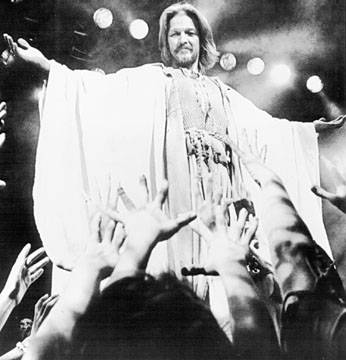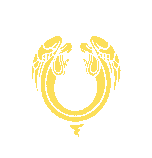


![]()

25TH ANNIVERSARY TOUR - 1993 - 1997
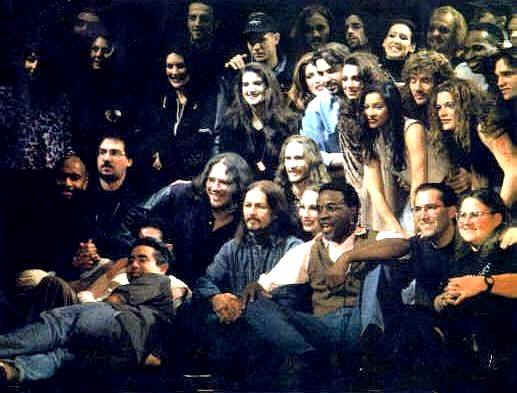
The cast of Jesus Christ Superstar during it's 4+-year tour.
Photo courtesy of Debbie Spykerman (spyk002@aol.com)
The best thing I can say about a tour that was supposed to last three months, but was so popular that it lasted nearly FIVE YEARS, and produced gross incomes approaching $100 MILLION DOLLARS, is that it showed an entirely new generation of people what some of us had already known from the original Broadway production and the film's initial release in 1972. Which is - that this is one great show, with a super cast of individuals.
The show itself was such a feast for all. Every time we saw the show, there were different things to marvel at. From the opening, to the Temple scene (there was NEVER a night that Ted's singing in that scene did not draw cheers from the audience), the candlelight in "Could We Start Again Please", the joyful dancing in "Simon Zealotes", the drama in the "Trial Before Pilate" and the sarcastic humor in "King Herod's Song" -- everything was an amazing piece to see at each performance. I remember our House Managers at Playhouse Square Center here in Cleveland telling us that we HAD to be back in the theatre for the last eight minutes of the show, because we ABSOLUTELY had to see Ted floating off the crucifix. One House Manager said it would "knock our socks off". We can attest to that! Another amazing special effect was Judas Iscariot's hanging. Both in the film and live on stage, when Carl jumped off the platform and hung by his neck, it was eerily real. One humorous aside to this, I was backstage after one of JCS' performances, and was reading the callboard while I waited to see Carl and Ted. There in all it's glory was a cast note:
"IN TONIGHT'S PERFORMANCE: JESUS WILL FLY, JUDAS WILL HANG."
This really cracked me up. I laughed so hard I almost fell over. Apparently, at different times during this tour, performances were done where the hanging and resurrection did not happen for various reasons. We got lucky that night.
Superstar also brought audiences much closer to its stars: Ted Neeley and Carl Anderson, who began their now-legendary autograph lines after their performances in Cleveland, Ohio in 1994. It enabled us to get the now-famous "Tedhugs", and let us show Ted and Carl how much we all love and admire them.
Unfortunately for us, Andrew Lloyd-Webber forced the tour's closing in 1997, when he began putting together his revival of JCS, which played on Broadway for one season, and closed in September, 2000. In Ventura in June, 2000, the question was put to Ted as to what the chances were that he would be playing Jesus again, now that the current production would be closing. His reply was: "Very good." (With Carl's passing, the proposed revival Ted and Carl were planning to open at the Vatican in 2004-2005 had not yet come to pass (of course, none of us even knew about the proposed new tour until Carl died). However, as posted below, Ted has been on the road with the A.D. Tour (nee: JCS - The Farewell Tour") - which commenced in September, 2006 and runs - at least - through early 2010, so, indeed, stranger things can happen after all! :-)
The final "full-production" performances of Ted and Carl's 25th Anniversary Tour of Jesus Christ Superstar were in Philadelphia, PA, where it closed on January 19, 1997.
~~~~~~~~~~~~~~~~~~~~
The audio recording of Gethsemane you are listening to was taken from an unofficial live recording of the final performance of the A.D. Tour on January 19, 1997 and given to me by fellow JCS fan and Ted Neeley list member John Conti.
Von (Shevonia) Thompson (dabaone@yahoo.com) posted this review/analysis of the final performance of JCS today (7/2/04), and it is an EXACT description of the full production of JCS on Ted and Carl's tour. Thanks, Von:
This is taken from the JCS.net. site. I do not know how accurate this article is, but it will give those of us who haven't had the pleasure of seeing the tour when it ran back in the 90's a chance to see what it might have been like. It is a review by Chip Harmison. The last part is an excerpt from Aunt Mary's " God's gift the world ".
Enjoy!
Act One
The play opens with the discordant sounds of the "Overture," smoke filling the floor of the stage, in the center of which is a platform whereon lie a man and a woman (representing Adam & Eve). They rise slowly and grab at the "Tree of Knowledge of Good and Evil" in the center of the platform to eat the forbidden fruit. The "Overture" kicks into high gear as hooded figures carry them away from the Garden of Eden.
Following this, men and women dressed in timeless peasant garb are groaning and shown cowering (a symbol of mankind's oppression through the ages) when Herod, then Caiaphas and Annas, then Pontius Pilate cross a catwalk, looking down on the people (literally & figuratively). After these unjust rulers leave, the people get up & form a circle stage left (audience right), one of them walking off to stage right (it is Judas, wearing a black leather jacket with a Harley Davidson logo). As the music crescendos into the instrumental intro to "Superstar," Jesus rises through the stage floor and up through the adoring followers, His head and hands lifted heavenwards. He is brilliantly lit. He then looks at His followers with total love. As the "Superstar" music ends abruptly and off-stage voices sound the wordless finale to "John 19:41," Jesus and Judas approach each other and embrace warmly - it is obvious there is a great deal of love and friendship between these two. When Judas goes back to stage right, three young female non-singing dancers clad in red appear to his right and use their hands to seemingly cast a spell on Judas (these ladies reappear at crucial moments throughout the play; they are Temptresses, goading Judas into his eventual betrayal of Jesus).
While Jesus warmly embraces each of his followers and takes time to listen to each one and respond to them (unheard by the audience), Judas sings "Heaven on Their Minds," surrounded by the Temptresses. When he comes to the conclusion of his song, Jesus and His followers have moved center-stage onto the platform (used for Adam & Eve) and are in frozen "tableau" as Judas wails, "Listen, Jesus!"
When this song ends, Jesus, the apostles and the faithful women "un-freeze" and the apostles begin an animated dance as they start singing "What's the Buzz?" Jesus is bemused (rather than annoyed) by their impatience and their determination to take over Jerusalem (it's obvious they've never really paid attention to Him or His Message). Mary Magdalene brings in a bowl of water and wipes the brow of a grateful Jesus, who points out that she is doing the right thing in offering comfort & kindness, but the apostles are undeterred and repeat "What's the Buzz?"
Judas enters, followed by the Temptresses. Jesus is happy to see him and extends His hand in friendship, but Judas (goaded by the Temptresses) launches into a diatribe against Jesus & Mary in "Strange Thing Mystifying." Jesus comforts Mary and listens to what Judas has to say, then responds that Judas should not cast stones; finally, sick of His apostles' self-involvement, Jesus lets them know He knows that none of them really care about Him, which they vigorously deny.
When the song is over, Jesus approaches front center-stage to respond to a spotlight that shines from above the audience only onto Him (it is God the Father). Jesus begins a conversation with Him, but is interrupted by a well-intentioned Mary, who proceeds to anoint Jesus' head and feet with ointment and sings the soothing "Everything's Alright," backed-up by the faithful women. Judas self-righteously tears into both of them again; Mary responds with a chorus of the song to Judas. Jesus gently tries to get Judas to realize they'll never stop poverty with their limited resources and to appreciate the good things he has. He places His right hand on a surprised Judas' right shoulder and gently tells him he'll be lost & sorry when Jesus is gone (He does this not as a threat, but as a gentle warning to try to keep Judas from making the mistake that will cause him to commit suicide). Judas puts his right hand on Jesus' arm, but backs away from Jesus, who is unflinching in His show of love for his troubled apostle as the women finish the song. The stage darkens & the company leaves.
Whereupon arrive the Temple Council, all bearing staffs, who conduct a meeting about what to do about Jesus and His ever-growing popularity; the high priests Caiaphas (whose basso profundo voice elicits cheers from the audience every time) and Annas (whose wheedling screeching tone elicits jeers from fellow priests every time) concludes "This Jesus Must Die" and all of the priests drop their staffs to meet at the head in agreement. The stage darkens and they leave.
A re-lit stage shows banners dropping from the rafters proclaiming "JESUS THE MESSIAH IS IN TOWN WITH ALL 12 DISCIPLES" and the like. Jesus is carried in on the shoulders of 2 of His apostles to a crowd waving palm branches and joyously singing "Hosanna." Caiaphas amd Annas appear on the catwalk above and Caiaphas jeers Jesus and His followers; Jesus good-naturedly tells him that if the crowd were silenced, the rocks and stones would start to sing. Annas, carrying a rolled-up scroll, leers nastily at Jesus, who joins the crowd for the final chorus.
The trumpets blare. Jesus calls Judas aside and instructs him to find out what the scroll Annas was carrying is about. Judas runs off to comply. The crowd joyously sing "Simon Zealotes" and Simon urges Jesus, who is enjoying this happy time, to encourage his followers to overthrow Rome. Jesus is dismayed by this and tries to caution Simon, who keeps singing of the "power" and "glory" that will be theirs as Simon & the crowd finish the song. Judas has returned with the scroll and shows it to Jesus; although it is not mentioned to the audience, it is obviously the priests' arrest warrant for Him & Jesus is shaken (this is based on historical fact - the ancient Jewish Talmud, section Sanhedrin 43a, contains the arrest warrant for Jesus and the info on His crucifixion at Passover; this was reportedly actually printed on the fake scroll). When the ardent followers finish their song with a mighty "Amen," Jesus gently and bittersweetly lets them know that their conception of power is not God's way and that Jerusalem, with her people bent on war against the Romans, is doomed (which, of course, came true in 70 AD). Jesus leaves, Simon and the followers unsure as to what's going on. The stage darkens and the company leaves.
A re-lit stage reveals a Roman guard in Pontius Pilate's quarters at the Fortress Antonia (across from the Jewish Temple); he is alerted into a defensive mode by off-stage screaming. The screamer comes on stage and turns out to be Roman procurator Pontius Pilate, who relates his foretelling nightmare of his dealings with Jesus and His accusers in "Pilate's Dream." The stage darkens and they leave. The re-lit stage reveals "The Temple," replete with unsavory-looking merchants hawking unauthorized Jesus mementos (such as buttons, hats and t-shirts) to capitalize on the popular leader's presence in town. A giant illuminated Jesus head & hands inflate to serve as a backdrop for their selling. Caiaphas and Annas come by. Caiaphas disgustedly rips in half a Jesus t-shirt, while Annas gladly collects the royalties from the merchants (overall, a wry commentary on capitalism and hypocrisy). Jesus and His apostles enter from stage left in discussion with one another, when Jesus stops in His tracks, utterly appalled by the misuse of His Persona for mercantile gains. He screams "My Temple should be a house of prayer..." and grabs a knife from a merchant rushing towards Him to stab Him (they're not about to let their good thing be stopped, even if it's by the One they're capitalizing on)! Jesus stabs the inflated head & hands, which "deflate," then, while saying, "Not in My Temple," struggles with other violent merchants seeking to stop Him. He overpowers the leader who is trying to attack Him with a staff and throws the staff to the ground. He screams, "Get out!" Judas is panic-stricken and keeps trying to remind Jesus of the danger He's in by showing Him the arrest warrant, but Jesus will not let His Father's House be made a mockery of. When Jesus screams "Get out" to the greedy gang, Judas tears the warrant in half and leaves. Jesus is alone and front-center-stage facing His Father (the spotlight) and sadly sings, "My time is almost through..."
He is (again) interrupted by a group of infirmed people in hooded robes who beg for His healing touch. He proceeds to heal them one by one until a crowd mobs and taunts Him, to which He replies, "Heal yourselves!" The crowd leaves, Mary enters and reprises "Everything's Alright," to which Jesus finally gets some sleep. The backdrop changes to a gorgeous midnight blue illuminated by hundreds of stars as Mary contemplates "I Don't Know How to Love Him" over His sleeping body. At song's end, the stage darkens and they leave.
"Then Judas Iscariot, one of the twelve apostles, went to the chief priests and asked, 'How much will you pay me to get Jesus into your hands?' And they gave him thirty silver coins. From that time on, Judas watched for an opportunity to betray Jesus to them." -- Matthew 26: 14-16
The re-lit stage reveals a confused Judas sitting on the center platform. A single event rarely causes a suicide. Rather, it is the victim's inability to cope with a series of events that leads them to the brink of self-destruction where some final event becomes the last straw. By the time we see Judas, he's already despondent. He's already hearing "voices." In short, he's already suicidal. It is Judas' hour; the hour of shadows. The Temptresses swirl around him. He tries to flee, but there is no escape. He hears the voices calling him by name. Then he desperately responds to what he thinks is the voice of Jesus. "Judas." He flees in the direction of the voice and then turns in terror. "Judas," laughs Caiaphas. He's been hearing the voices of the priests imitating Jesus to get his attention. Annas blocks the path of his escape and Judas falls to his knees. He is desperate to find a way to save his dreams, his mission and his life. Caiaphas and Annas (and the Temptresses) surround Judas, who spills his guts about his ever-increasing doubts in "Damned for All Time." The priests salaciously offer him "Blood Money" to get him to lead their soldiers to Jesus when He's not surrounded by crowds. He doesn't want the money and yet he suddenly finds it in his hands. Despite his protests, Annas has dropped the silver into his open hands. Finding it there destroys him. Maybe he feels that everything is out of his control. Maybe he thinks there is no other way. Maybe he's wrong. It is a tragic moment. Judas gives in, but realizes what he's done. Caiaphas and Annas are not his friends. As soon as they have the information they want, they abandon him. He feels horribly alone and lost. He curls into a fetal position on the floor and cries out in agony. The sound seems to come from the depths of hell itself. "No-o-o!" He screams out Jesus' name as the first act curtain descends. The curtain falls and it's as if a prison door has slammed.
Act Two
Curtain rises on the center platform, which is illuminated to (tastefully) represent a round stained-glass window covered by a white cloth. Judas sits dejected at stage right as the Faithful Women enter, followed by the Apostles (one at a time from opposite ends of the stage, meeting at the middle to descend the steps to this, the original Round Table a la King Arthur's Knights) singing the chorus to "The Last Supper." Jesus is the last to enter and tragically muses on His fate being handled by His own friends as He distributes the bread and wine to the apostles at either side of Him. He realizes they STILL don't get Him or His purpose, so He flatly tells them one of them will deny Him, another betray Him. The Apostles (except for a nervous Judas, who tries to flee, but is pushed back by the Temptresses) vehemently protest this, so Jesus names Peter as His denier and when starting to name His betrayer, Judas explodes and Jesus urges him to go ahead and get it over with. The apostles are confused; they sing their second chorus as Jesus wipes their feet. Judas kneels down and clasps Jesus' head with his hands. When he sees the bag containing the blood money tied to his belt, he jumps to his feet and launches into his nastiest diatribe against his Master yet, while Jesus holds off the angry apostles ready to throttle the traitor. Judas finishes his venom and falls to his knees and into Jesus' loving embrace with Judas wrapping his arms around Jesus' waist; it is obvious they are both devastated by this. Judas leaves with Jesus following him, His arms still outstretched to welcome back his tortured, wayward friend, who goes off-stage, dashing off into the darkness. The apostles sing their third chorus as they, too, leave the stage and the women wrap up the tablecloth. Drowsy from the journey, the food, the wine, the apostles drift off to sleep. Jesus turns to smile at Mary, who is once again trying to comfort Him , but He sees the Light (His Father God) and turns towards Him. Mary leaves & Jesus is alone, poignantly singing, "Will no one stay awake with Me? Peter? John? James? Will none of you wait with Me? Peter? John? James?" Alone. Afraid. Heartbroken. All He wants is for someone to be there with Him.
He now, finally, gets to have an extended discussion with His Father and is center stage to sing the haunting "Gethsemane (I Only Want to Say)," in which a tired and hurt Jesus pleads for His life (the star-lit background from "I Don't Know How to Love Him" re-appears for this entire scene); during the instrumental coda, Jesus turns His back and walks to the back of center-stage shouting "No" at the prospect of dying when, at the coda's climax, thunder sounds and strobe lights convey lightning to show that it is God's will for Jesus' substitutionary death. Jesus acquiesces and finishes the song (to what is usually a standing ovation that stops the show cold for several minutes).
Judas and the Temple party arrive for "The Arrest" and the apostles awaken to fight the soldiers. Jesus puts a stop to the violence and tosses Peter's sword to the ground; the apostles flee and Jesus allows Himself to be captured by the soldiers, who place two evenly-lengthened metal poles in an X-cross formation between His elbows & knees. In another bit of subtle social commentary, trench coat and hat-clad reporters step in with microphones to get Jesus' reactions to their cynical questions. They gleefully take Jesus (whom the soldiers uplift on their poles so that Jesus is raised up parallel to the ground) to Caiaphas & Annas, who gleefully condemn Him into Pilate's hands. They leave the stage, whereupon Peter encounters a maid, a soldier and an old man by a campfire; they recognize Peter from being with Jesus, which he vehemently denies in "Peter's Denial," to the dismay of Mary, who wonders how Jesus knew that would happen...
Jesus is brought in by Roman guards and shoved to His knees in the palace of Pilate, who makes a grand entrance and sarcastically comments on Jesus' tattered appearance in "Pilate and Christ." He sends him off to Herod (the puppet "king" of Jesus' homeland, Galilee) while the mob (who have turned on Jesus for not using His power against the Romans) deride Him as He is taken to the court of drag queen/effeminate Elvis impersonator Herod. Things are pretty intense by the time Jesus is forced to his knees at Herod's palace. Herod injects some levity with "King Herod's Song," but, in a strange way, it makes him seem all the more menacing. Herod's palace is a den of iniquity and depravation. Herod moons Jesus while a member of his heavily made-up court takes a quick flash Polaroid of His face. Herod takes sadistic pleasure in tormenting his prisoner. He takes his riding crop and puts a chokehold on Jesus' throat. Herod sarcastically tries to goad him into performing miracles. Like a spoiled child, Herod throws a tantrum when Jesus refuses to perform for him. He slips off one of his gloves and wraps it seductively around Jesus' neck, the threat apparent. But when even this fails to provoke a response, he pulls it tight like a noose. At the very last minute, he releases it with a dirty laugh and kicks Jesus over, sending him sprawling on the ground. Jesus, his arms bound behind his back, struggles to his knees, but offers no defense to Herod's brutal attacks. The courtiers roughly pull him to his feet and drag him from the palace as Herod angrily sends Him back to Pilate.
In the midst of this cruelty comes a song/scene of gentility and respite. The star-lit background re-appears as Mary (in a hooded robe) shows up center-stage on the platform carrying a lit candle singing "Could We Start Again, Please?" She is joined by Peter (also clad in a hooded robe), who lights the candle he's carrying from hers, as does Simon Zealotes and all of Jesus' (remaining) followers (again, all clad in hooded robes, lighting their candles from each others' wicks). This scene is unbelievably moving in its simplicity. However, we know we're going back to the tragedy when they put out their candles and leave.
Judas is appalled at what Jesus is being put through, but worries mostly about how he'll be viewed in "Judas' Death," much to the bewilderment of Caiaphas & Annas. After they leave, Judas reflects on his mixed feelings about Jesus, then is goaded by the Temptresses into blaming God for his actions. This is very eerie. The guitar opening to "Heaven on Their Minds" (now played discordantly) plays as Judas is pushed into suicide by the Temptresses. We see Jesus and his guards in eerie strobe lights, as if being seen in a vision. They have tormented his friend horribly. How much worse is it, then, to be the man who delivers his friend into the hands of the abusers? Haunted by what he has done and driven by the Temptresses, Judas slips a noose they give him around his neck, then the music comes to a sudden stop as Judas hangs himself, dangling in silhouette against a fierce red backdrop.
Jesus is once again roughly shoved into the palace of Pilate, who is surprised at the determination of Caiaphas and Jesus' fickle (former) followers (now a bloodthirsty mob) to have this innocent man crucified and tries to get to the bottom of it all in "Trial Before Pilate." When the music from "Pilate's Dream" plays, Pilate realizes this is the man whose fate he will determine and tries to sway the crowd against crucifying Jesus, but the crowd is relentless in their cry for crucifixion. Unable to stop the crowd, he orders Jesus' flogging to try to appease their bloodlust and to (hopefully) make them more sympathetic to Jesus' plight with the line "To keep you vultures happy, I shall flog Him!" "No!" cries Mary Magdalene. "He's an innocent man!" But the guards grab her and carry her off. Pilate's soldiers tie Jesus' arms to stakes, rip the clothing from His back and zealously begin doling out the sentence. They are brutal. They are supposed to be alternating lashes, but, on several occasions, they both strike him at the same time. After thirty-nine counts, they cut him loose and Jesus crumples, collapsing to the ground, broken and bleeding. Pilate then questions a dying Jesus about who He is. Jesus acquits Pilate for his role in this, but Pilate takes it the wrong way and gives in to the crowd, washing his hands of it. Pilate and the mob leave while Jesus staggers to His feet and reaches out to Mary & Peter, who are kept away by the Roman soldiers. They leave Jesus alone on the center stage platform as the instrumental intro to "Superstar" crescendos, Jesus becoming a silhouette against blindingly flashing strobe lights.
The curtain descends in front of Him and the actor playing Judas (dressed in modern clothing, a sharp-looking white suit with a white sequined vest, representing "Everyman") walks across the stage in front of the curtain, eventually joined by the "Soul Girls," wearing odd hats, who all query Jesus as to His identity and mission. The title song climaxes as they leave the stage and the curtain rises.
The sound of nails being hammered is heard, a dark edifice is rising from center stage. When fully erect, it is lit to show Jesus nailed to the cross, writhing in torment and speaking the famous "Seven Last Words from the Cross" in the "Crucifixion" scene as eerie music plays. Two mocking Roman soldiers and the grieving faithful women (including the Virgin Mary, for whom Jesus calls out in His grief) surround the cross. When Jesus commits His spirit into the hands of His father, His body comes forward and He breathes His last - a sound heard as if all the wind in the world were being expelled. As the wind dies down, "John 19:41" is mournfully started as Jesus bows His head & His dead body sags downward from the cross and the women bow their heads, BUT the tempo of the song changes mid-way as Jesus is resurrected from the dead! He looks stunned and then His body moves out and away from the cross. As He slowly rises upward, He looks bittersweetly at the faithful women (who raise their heads & are stunned!) whom He's taking leave of and then He looks fearlessly into Heaven, relieved at being over His trials & torments, happily anticipating His return to God the Father, who has vindicated Him after all the misunderstanding and betrayal He has endured. When He is fully ascended out of view, the women and soldiers (who are also stunned) turn to face the audience, their gazes still lifted Heavenwards as tiny beams of light emit from the center of the cross in time to the closing notes of the music, which ends, not mournfully as it had started, but triumphantly. The curtain descends while Ted gets out of the safety harness he wore to fly off and puts on his last costume.
The curtain rises to reveal the center-stage cross fully illuminated. Each cast member takes a bow; then it's time for the countdown to Jesus! Huge spin and one finger from Carl, then another spin and two fingers (keeping the audience on the edge of their seats), then the final spin and three fingers sending them into a fever pitch. As the orchestra breaks into the strains of the familiar theme, at last, Ted comes out in a spotless white robe we've not seen before (to symbolize His glorification) and hugs Judas in a show of forgiveness. The crowd is on its feet, the applause threatening to drown out the orchestra completely. Hands folded across His heart, Ted takes His bow and then extends one hand to the orchestra and the other to the rest of the cast. The cast members join hands, with �Jesus� and �Judas� in the middle, to take repeated bows to thunderous ovations. A woman in the first row tries to reach across the orchestra pit to hand a huge bouquet of roses up to the stage. Ted makes His way to the edge of the stage, then raises his eyebrows and places His hand upon His chest, as if to ask, "For me?" The woman smiles shyly and holds out the bouquet. "Thank you," He mouths above the roar of the audience. He bends down and reaches across the orchestra pit to retrieve the roses, then waves the bouquet in the air and bows to more applause.
CAST AT THE TOUR'S FINAL PERFORMANCE:
Ted Neeley as Jesus of Nazareth
Charles DiMaria as Judas Iscariot (Carl Anderson played Judas in the '98 post-tour shows in Ventura)
Christine Rea as Mary Magdalene
Scott Spalding as Pontius Pilate (James O'Neil played Pilate in
Christopher P. Carey as Caiaphas
C.T. Butler as Annas
Anthony DiBenedetto as Simon Zealotes
Randy Millheim as Peter
Scott White as King Herod
James Paul as Soldier by the Fire
Erika Insana as Maid by the Fire
Charles LeTrelle Holt as Old Man by the Fire
Priests: Patrick Herwood, Seth Hampton, James Paul
Swings: Emily Frangipane, Patrick Herwood
Soul Sisters: Erika Insana, Kirsten E. Gerding, Liza Shaller
Temptresses: Christene LeBeau, Danielle Gruzas, Jennifer Watkins
Last edited by JCSSExpert on Sun May 02, 2004 12:28 pm
Stage Shots From the 25th Anniversary Tour and Other Tours
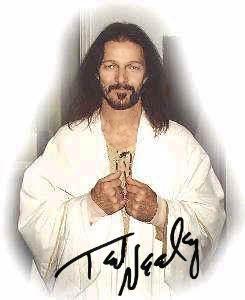
Photo Courtesy of Jan Stetler
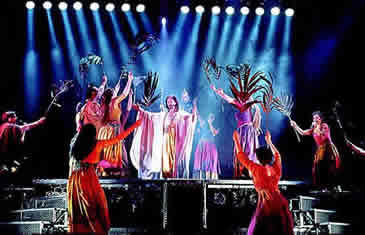
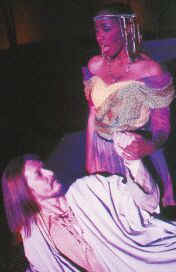 |
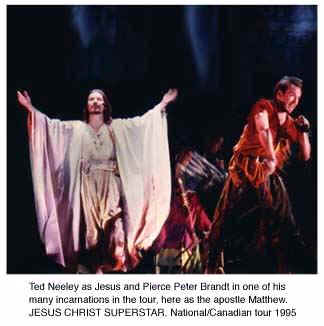 |
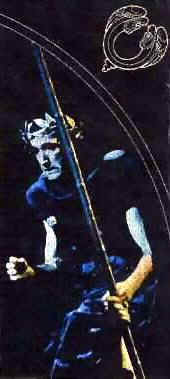 |
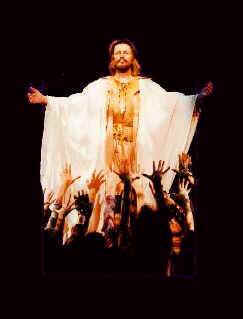 |
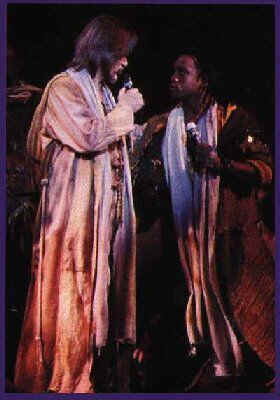 |
|
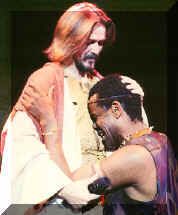 |
||
|
|
 |
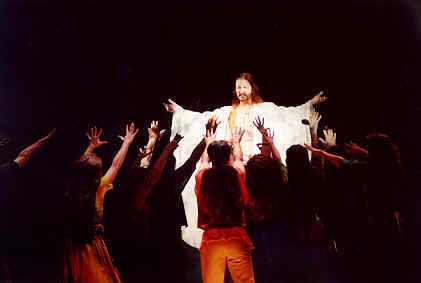 |
|
 |
||
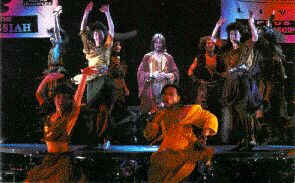 |
||
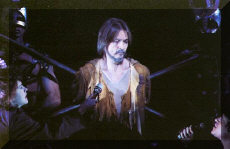 |
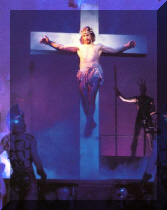 |
| Photos courtesy of: http://darkstreet.hostrack.com/ | |

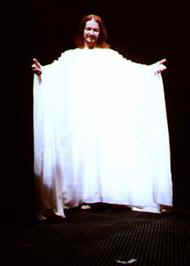
Courtesy of Kellylee
(http://www.geocities.com/Broadway/2596/
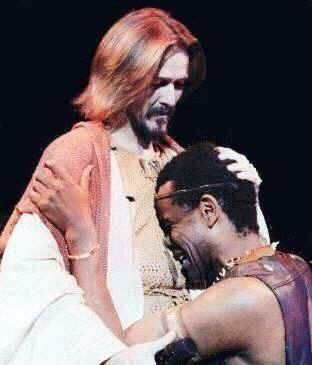
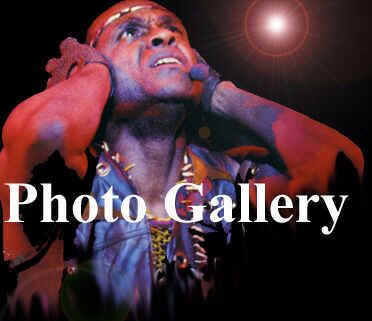
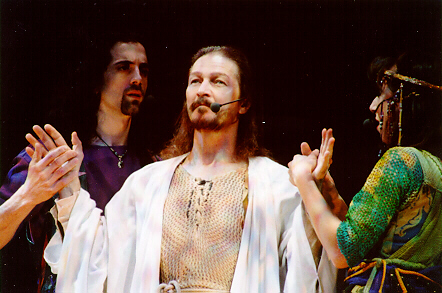
Photo courtesy of : http://www.chuckdimaria.com/jcs.jpg
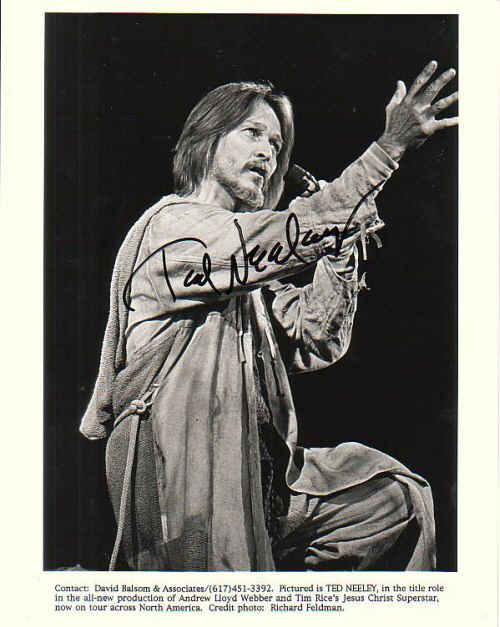
Photo on e-Bay - found courtesy of Mianne Tripp (mtripprn@hotmail.com) - Thanks, Mianne!
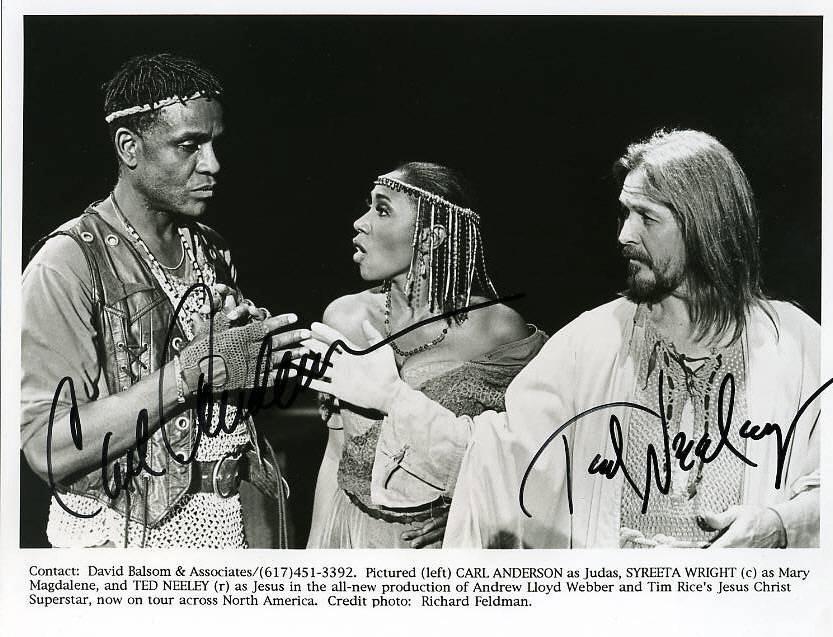
Thanks for the great find, Helena! (hnc62ngg@telecable.es)
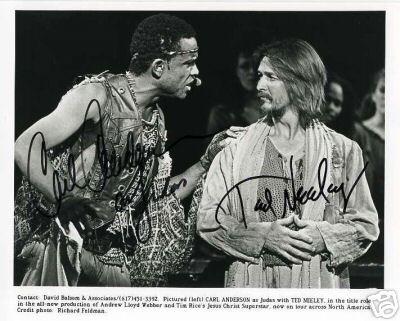
Thanks, Alessandra!
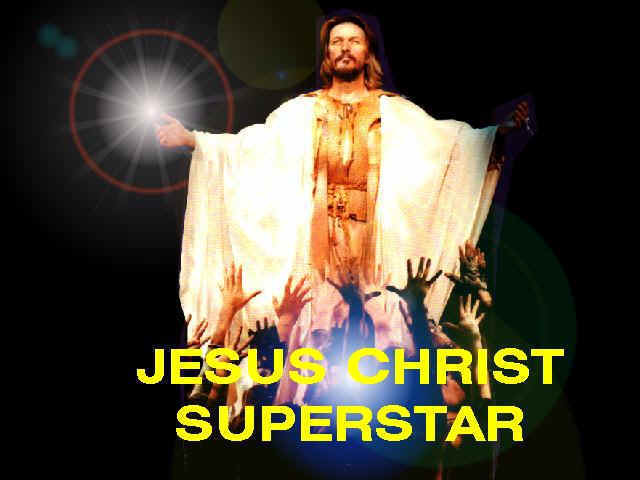
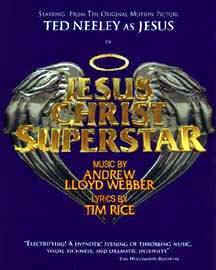
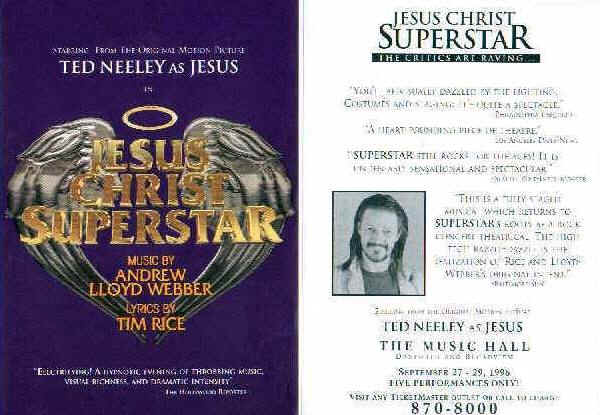
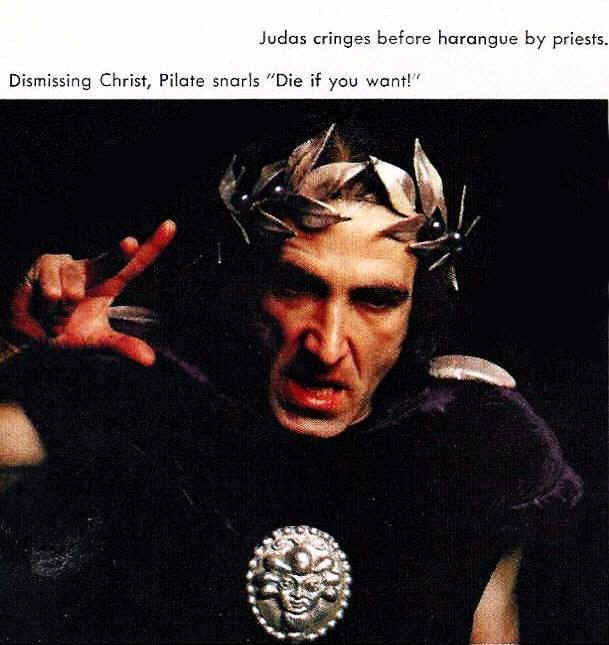
I bought these 2 wonderful stage stills below at RTC while we were out there to see "Murder In The First" in June, 2000. My Salespeople? Tessa and Zach!
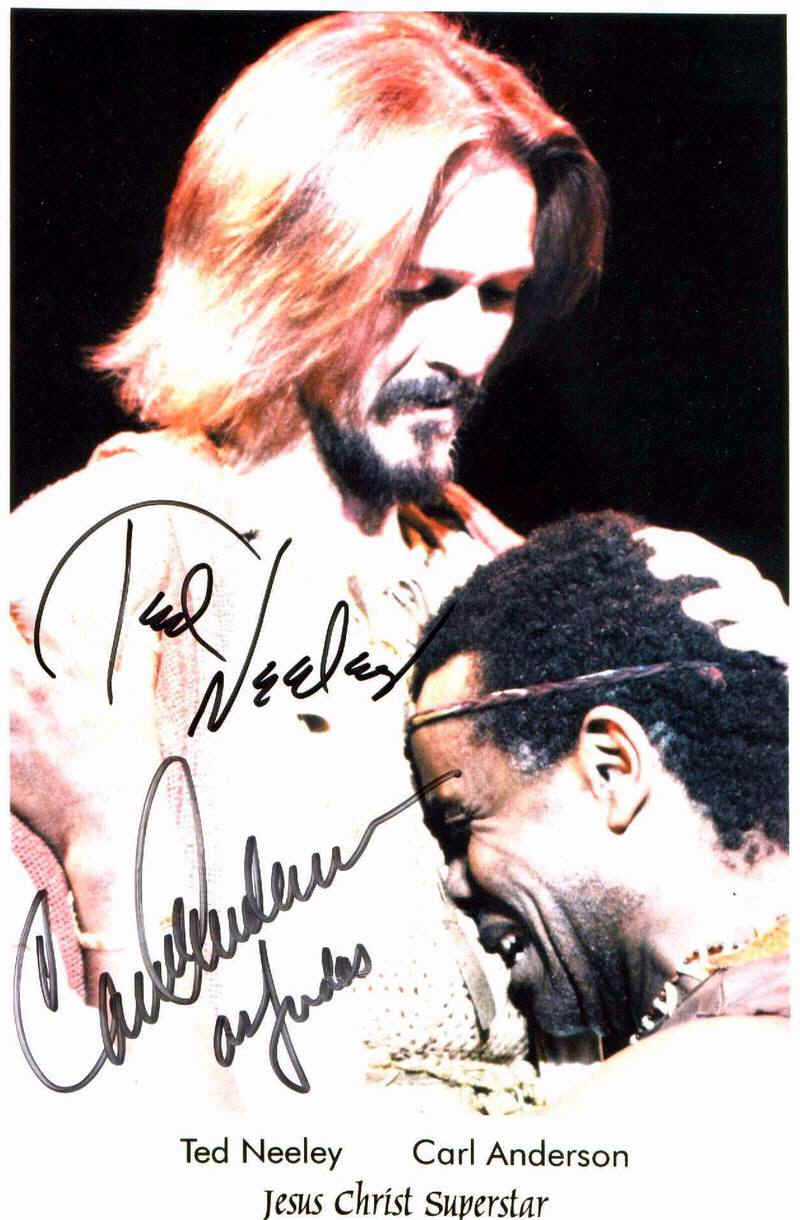
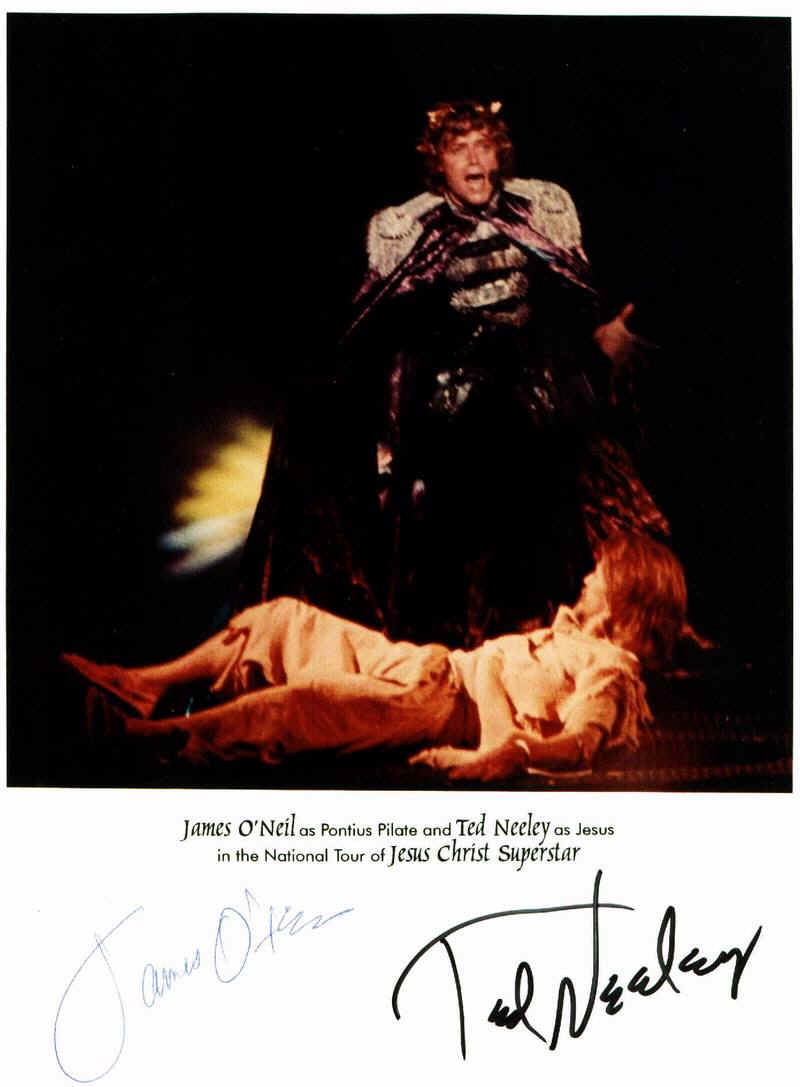
Here's one advertisement from Iowa, 1996 - again from Linda - which includes the picture below:
http://www.daily.iastate.edu/volumes/Spring96/Mar-19-96/ph-christ.html
